Bigtooth Aspen
Arbor Walk #155, Treekeeper ID #8051

Like many aspens, the Bigtooth Aspen is relatively short-lived, fast-growing, spreads through suckers, and has distinct fluttering leaves. This aspen is found in the northeastern United States and southeastern Canada, and has distinctly egg-shaped leaves with blunt, narrow teeth and flattened petioles. This species has an affinity for sandy soils and requires total sunlight.
Suckering is a form of vegetative growth in which new trees grow from shallow horizontal roots of existing trees rather than via pollination and seedling recruitment. Aspens often form colonies of these “clones”, which may be solely male or female when isolated (making sexual reproduction even more difficult). This is the dominant form of growth for the Bigtooth Aspen.
| Common Name | Bigtooth Aspen |
|---|---|
| Latin Name | Populus grandidentata |
| Indigenous Name(s) | |
| Cultivar/Variety | |
| Commercial Name |
Global Distribution



GPS Coordinates
N/A
Percent Concrete
N/A
Distance to Buildings
| Year | Close Building #1 | Close Building #2 | Close Building #3 |
|---|---|---|---|
Distance to Other Species
| Year | Close Species #1 | Close Species # 2 | Close Species # 3 |
|---|---|---|---|
Standard Measurements
| Year | Height (m) | DBH (cm) | Crown Diameter N-S (m) | Crown Diameter E-W (m) | Average Crown Diameter (m) |
|---|---|---|---|---|---|
Nests and Pests
| Year | Description |
|---|---|
Leaf Identification
The leaves of the Bigooth Aspen are ovate with a dentate (toothed) margin. The teeth on the margin are rounded and can very in size and number. The leaves are green above and yellow-green below. The petiole is long and flattened, allowing the leaves to flutter in the breeze.
Twig and Bud Identification
The twig is slightly zigzag, and the leaves are arranged alternately on the twig. The twigs mature to a tan-brown color from a yellowish-green color when immature. The buds are reddish brown, conical, and acutely pointed, with imbricate scales.
Bark Identification
The bark of the Bigtooth Aspen starts mostly smooth, developing ridges and eventually deep furrows on its gray bark with maturity.
Fruit Identification
The fruits of the Bigtooth Aspen are small seeds with white cottony hairs that help them disperse on the wind when they are released from the female catkins.
Flower Identification
Bigtooth Aspens are dioecious, with separate male and female trees. Both the male and female flowers are inconspicuous and held on catkins up to three inches long. Aspens are wind-pollinated with pollen from the male catkins blown on the wind to the female catkins.
ID Key Tips
- The Bigtooth Aspen is similar to the Quaking Aspen, which inhabits similar areas of the Northeast U.S.; however, the Bigtooth Aspen can be distinguished by its ovate leaves without an acute tip, making it truly egg-shaped, whereas the Quaking Aspen has a long acute tip at the end of its ovate shape.






